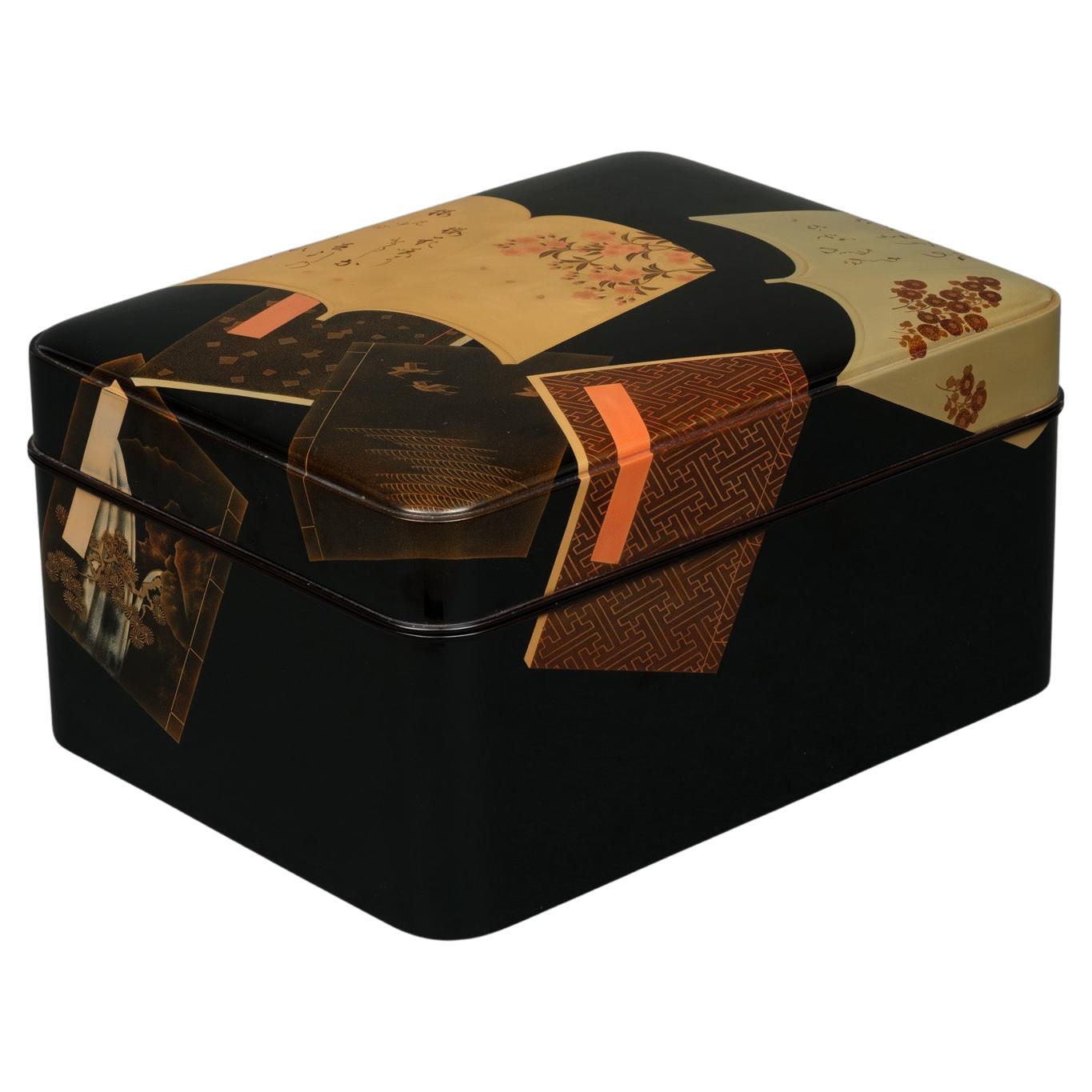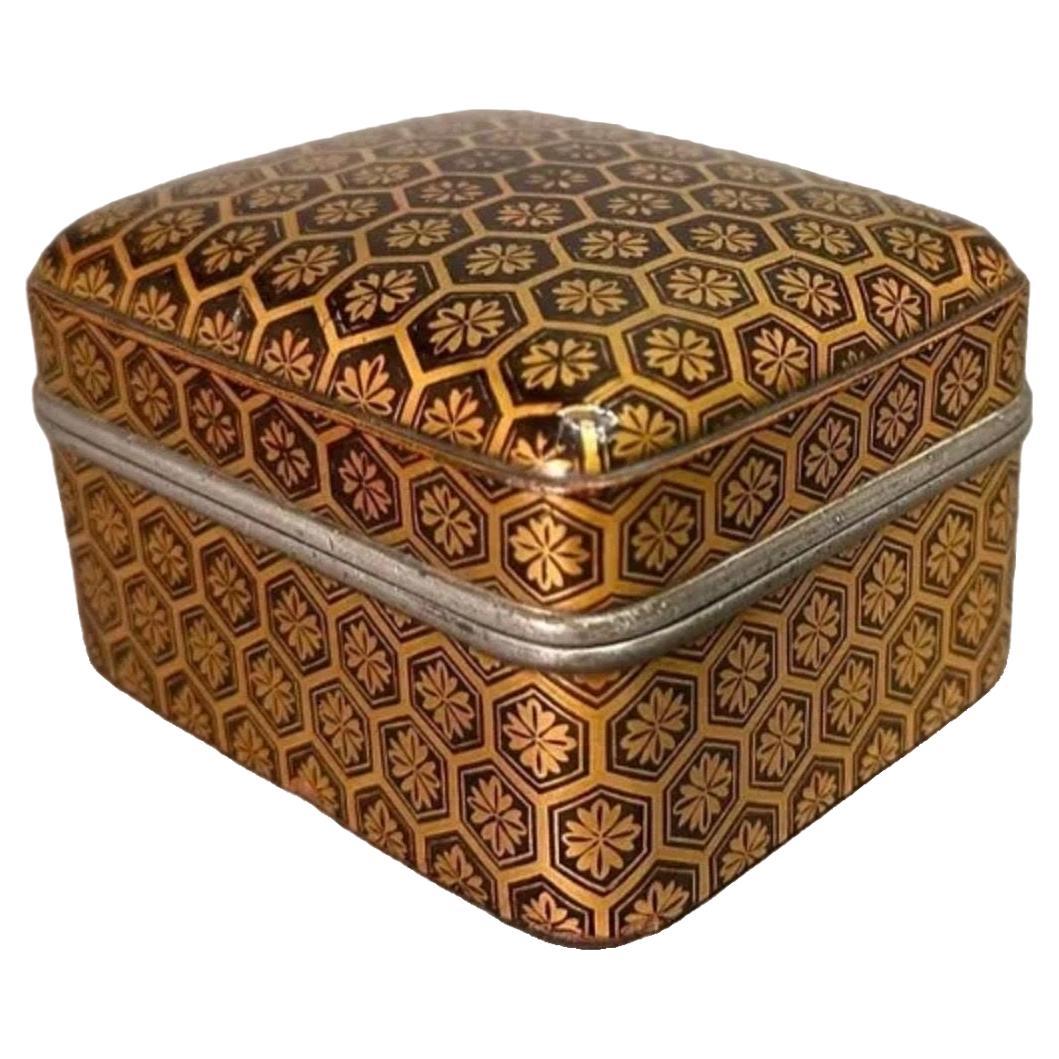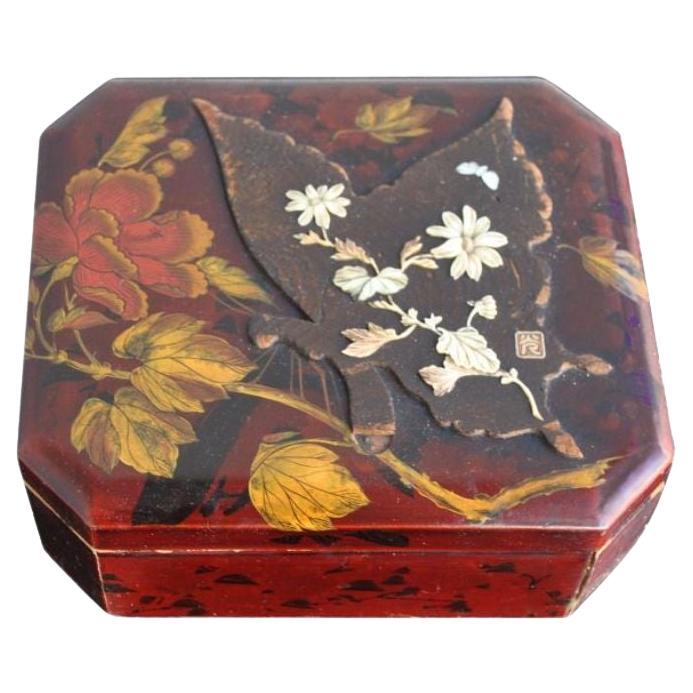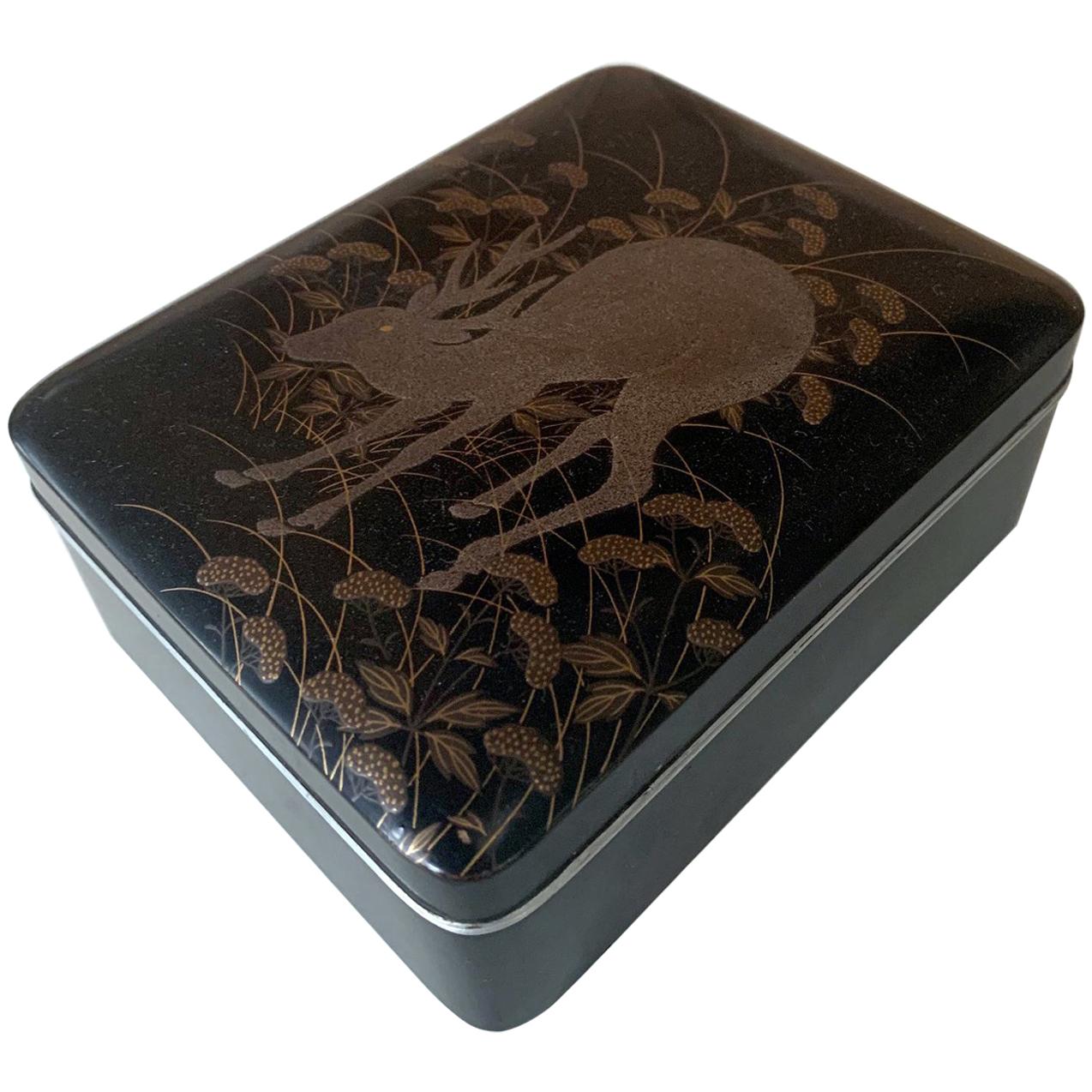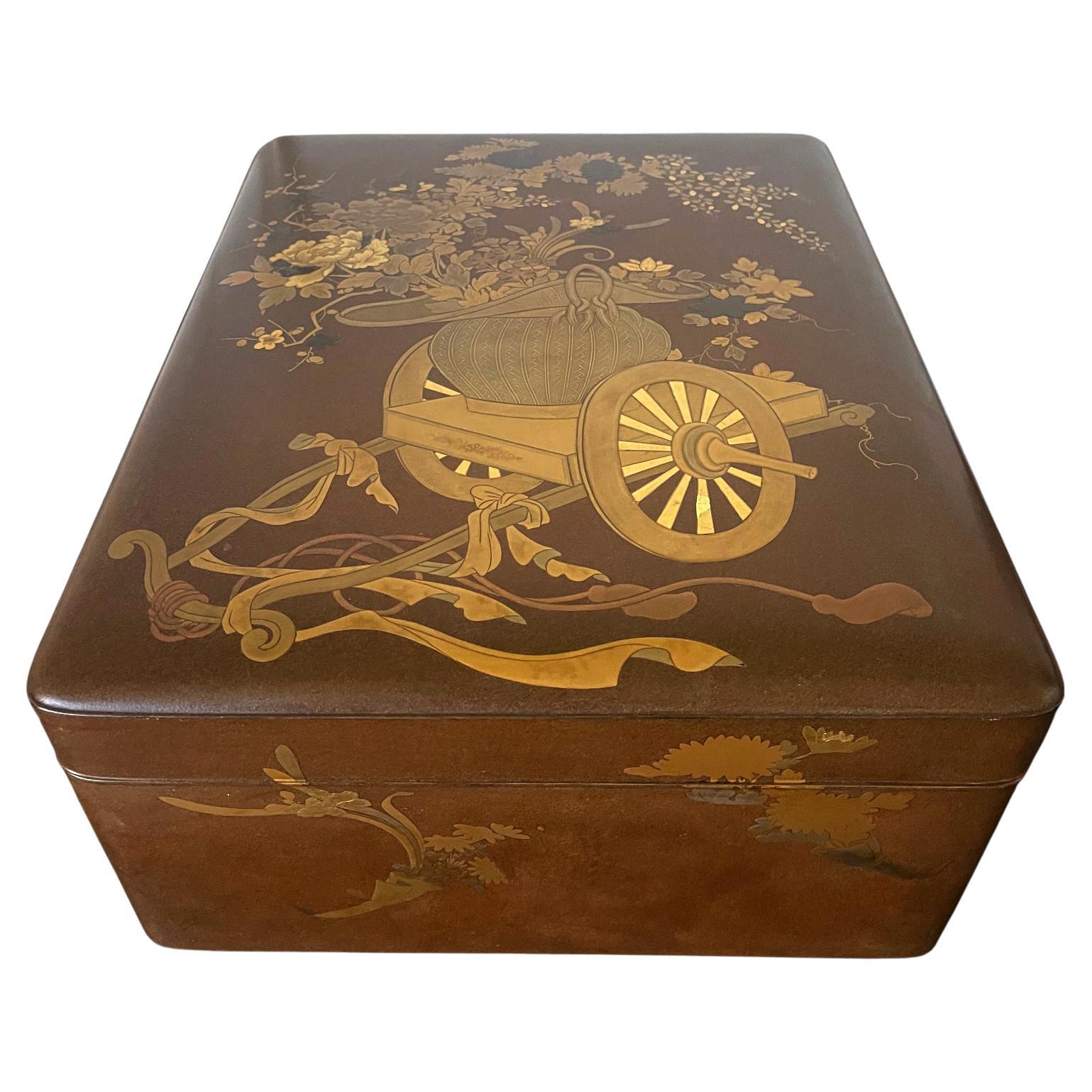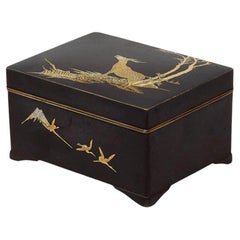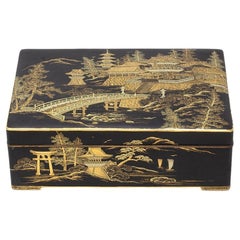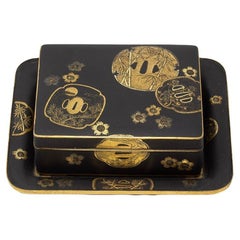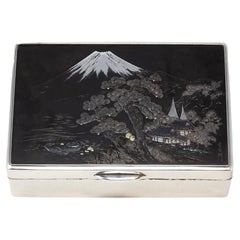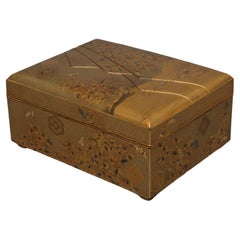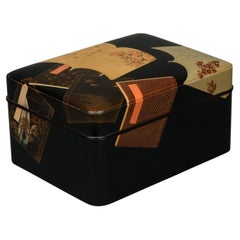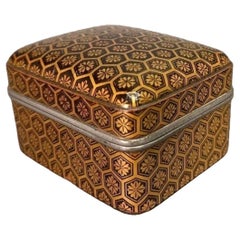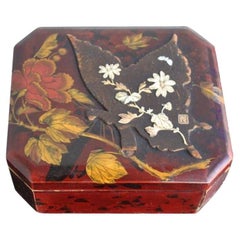Items Similar to Important Japanese Lacquer Presentation Box Gifted by Japanese President to RAF
Want more images or videos?
Request additional images or videos from the seller
1 of 21
Important Japanese Lacquer Presentation Box Gifted by Japanese President to RAF
$12,357.64
£9,000
€10,514.95
CA$17,160.01
A$18,725.55
CHF 9,821.87
MX$227,428.07
NOK 122,680.52
SEK 115,939.23
DKK 78,479.60
About the Item
PRESENTED BY THE 21ST PRESIDENT OF JAPAN
From our Japanese collection, we are absolutely delighted to bring to market this Important Japanese Lacquer Presentation Box. The Presentation Box of rectangular form with rounded corners is made from lacquer with a beautifully decorated exterior displaying an extensive base of blooming chrysanthemum flowers upon a gold ground. The lid of the box lifts off and is mounted to the top and bottom in silver to protect the lacquer. The interior of the presentation box is covered in Nashiji lacquer with Japanese calligraphy in the lid reading 贈呈 ロートン英國空軍大尉貴下 海軍大臣男爵加藤友三郎 , 大正十二年一月, 古杳 – Presented as a gift to Captain Lawton (British) Royal Air Force by Minister of the Navy Baron Kato Tomosaburo, January of the 12th year of Taisho (Jan 1923) by Kosugi. With the important provenance inside the box dates to the 12th year of Tashio which is just after the Meiji Period (1868-1912) and before the Showa period (1926-1989) and coincidentally fits within the years term of Kato Tomosaburo as acting Prime Minister of Japan.
KATO TOMOSABURO (1861–1923)
Marshal-Admiral Viscount Kato Tomosaburo was a Japanese admiral and statesman who served as the Prime Minister of Japan from 1922 to 1923. A highly respected naval officer, he played a key role in modernising Japan’s navy and was instrumental in Japan’s participation in the Washington Naval Conference (1921–1922), which sought to limit naval armaments among major world powers. As Prime Minister, Kato prioritised financial and military reforms, advocating for reduced defence spending to stabilise Japan’s economy. His leadership, though brief, was marked by a commitment to diplomacy and pragmatism. However, his tenure was cut short when he passed away in 1923 due to illness. Despite his short time in office, Kato left a lasting impact on Japan’s naval policies and international relations.
Kato Tomosaburo was Posthumously awarded Grand Cordon of the Order of the Chrysanthemum on the 24 August 1923. The grand cordon is the highest possible honour a Japanese citizen can be awarded during his or her lifetime. Aside from members of the Imperial Family, 53 Japanese citizens have been decorated with the grand cordon; of these, only 23 were living at the time of receipt. The Supreme Order of the Chrysanthemum (大勲位菊花章, Dai-kun’i kikka-shō) was established in 1876 by Emperor Meiji of Japan and the Collar of the Order was added on 4 January 1888. This indicates the high importance of Kato Tomosaburo and the legacy he left behind in Japanese politics and culture.
TAISHO PERIOD (1912–1926)
was a fascinating time in Japan—often seen as a bridge between the highly controlled Meiji era and the more militarised Showa era. It was a period of political change, cultural shifts, and growing international engagement. Unlike the previous emperor, Meiji, who was a strong and active ruler, Emperor Taisho had poor health, which meant that power shifted more toward parliamentary government and democracy. This led to what’s sometimes called “Taisho Democracy,” where political parties gained more influence, and Japan experimented with a more liberal, modern society.
Culturally, Japan was opening up to Western influences in fashion, art, and even everyday life. Cities like Tokyo and Osaka were bustling with jazz music, new technologies, and modern infrastructure. You could see men in suits and bowler hats alongside women in kimono experimenting with Western-style clothing. On the global stage, Japan was gaining recognition as a major power. It fought on the side of the Allies in World War I, which helped expand its influence in China and the Pacific. However, economic struggles and political instability were also brewing, setting the stage for the more turbulent Showa era that followed.
NASHIJI LACQUER (梨地)
is a traditional Japanese finishing technique used in lacquerware, characterised by a subtle, shimmering surface that resembles the texture of pear skin. This effect is achieved by sprinkling fine gold or silver powder onto a layer of wet urushi lacquer before sealing it with additional transparent or semi-transparent lacquer layers. Once polished, the surface takes on a soft, speckled appearance with a delicate metallic sheen. Popular during the Edo period (1603–1868) and beyond, Nashiji was commonly used in luxury objects such as inro, writing boxes, tea caddies, and furniture, adding an understated yet refined sophistication. This technique remains highly valued in Japanese craftsmanship for its beauty and durability.
CHRYSANTHEMUM
is the national flower of Japan it represents the sun and the light (immortality) in Japan. It is also used as the Imperial Seal of Japan or National Seal of Japan called the Chrysanthemum Seal (菊紋 kikumon). It is the mon used by the Emperor of Japan and members of the Imperial Family. During the Meiji period (1868–1912), no one was permitted to use the Imperial Seal except the Emperor of Japan, who used a 16-petalled chrysanthemum with sixteen tips of another row of petals showing behind the first row.
- Dimensions:Height: 2.56 in (6.5 cm)Width: 5.71 in (14.5 cm)Depth: 4.53 in (11.5 cm)
- Style:Art Deco (Of the Period)
- Materials and Techniques:
- Place of Origin:
- Period:
- Date of Manufacture:1923
- Condition:Wear consistent with age and use.
- Seller Location:Newark, GB
- Reference Number:Seller: EDDYS1stDibs: LU6971245586912
About the Seller
5.0
Gold Seller
Premium sellers maintaining a 4.3+ rating and 24-hour response times
Established in 2019
1stDibs seller since 2022
39 sales on 1stDibs
Typical response time: 2 hours
- ShippingRetrieving quote...Shipping from: Newark, United Kingdom
- Return Policy
Authenticity Guarantee
In the unlikely event there’s an issue with an item’s authenticity, contact us within 1 year for a full refund. DetailsMoney-Back Guarantee
If your item is not as described, is damaged in transit, or does not arrive, contact us within 7 days for a full refund. Details24-Hour Cancellation
You have a 24-hour grace period in which to reconsider your purchase, with no questions asked.Vetted Professional Sellers
Our world-class sellers must adhere to strict standards for service and quality, maintaining the integrity of our listings.Price-Match Guarantee
If you find that a seller listed the same item for a lower price elsewhere, we’ll match it.Trusted Global Delivery
Our best-in-class carrier network provides specialized shipping options worldwide, including custom delivery.More From This Seller
View AllJapanese Meiji Period Damascene Box by Ashizuki with Gold and Silver
Located in Newark, England
INLAID WITH A GOLD AND SILVER DEER
From our Japanese collection we are pleased to offer this Japanese Damascene Box by Ashizuki. The Japanese Box of re...
Category
Antique 19th Century Japanese Meiji Metalwork
Materials
Gold, Silver, Brass, Iron
Japanese Mixed Metals Box by Fujii Yoshitoyo, Meiji Period
By Fujii Yoshitoyo
Located in Newark, England
IMPRESSIVE SIZE MIXED METALS BOX
From our Japanese collection, we are pleased to offer this Japanese Mixed Metals Box by Fujii Yoshitoyo.
This substantial rectangular box, raised u...
Category
Antique Late 19th Century Japanese Meiji Metalwork
Materials
Metal, Gold Plate, Silver, Brass
Antique Japanese Meiji Period Tsuba Decorated Box and Dish by Fujii Yoshitoyo
By Fujii Yoshitoyo
Located in Newark, England
Original Box and Dish Pair
From our Japanese collection, we are pleased to offer this Japanese Komai Style Box and Dish Fujii Yoshitoyo. The Box of slim rectangular shape seated upo...
Category
Antique Late 19th Century Japanese Meiji Metalwork
Materials
Metal
Japanese Meiji Period Silver and Mixed Metals Cigar Decorative Box by Hidekuni
Located in Newark, England
From our Japanese collection, we are delighted to introduce this Japanese Silver and Mixed Metals Box by Hidekuni. The Japanese Box of large rectangular form lined in a dark asian ro...
Category
Antique Early 1900s Japanese Meiji Cigar Boxes and Humidors
Materials
Gold, Silver
Japanese Antique Meiji Period Vesta Case by Fujii Yoshitoyo
By Fujii Yoshitoyo
Located in Newark, England
DEPICTING A MYTHICAL HO-O PHOENIX
From our Japanese collection, we are delighted to offer this Japanese Vesta Case by Fujii Yoshitoyo. The Vesta Case extensively decorated with gol...
Category
Early 20th Century Japanese Meiji Tobacco Accessories
Materials
Gold Plate, Brass
Italian Silver and Enamel Box
By Franco Salimbeni
Located in Newark, England
GUILLOCHE ENAMEL AND SILVER GILT
From our collectables category, we are delighted to offer this incredible quality Italian Mid-Century Modern Silver and Enamel Box. The Silver and E...
Category
Late 20th Century Italian Mid-Century Modern Snuff Boxes and Tobacco Boxes
Materials
Gold Plate, Silver, Enamel
You May Also Like
Exceptional Japanese Gold Lacquer Tebako 手箱 'Box for Personal Accessories'
Located in Amsterdam, NL
Exceptional Japanese rectangular gold lacquer tebako (box for personal accessories) with a slightly domed well-fitted lid and raised by four low bracket feet. The lid finely carved with pointed shapes as if it is covered by folded papers.
On top of this embossed surface it is decorated with gold and silver hiramaki-e (low-relief design) and takamaki-e (high-relief design) depicting a wild winding river landscape with along the waterfront...
Category
Antique 19th Century Japanese Lacquer
Materials
Giltwood, Lacquer
Japanese lacquer tebako 手箱 (box for personal accessories) with book design
Located in Amsterdam, NL
Superb rectangular black lacquer tebako (box for personal accessories) with a slightly domed well-fitted lid.
The lid has a continuous soft-tone multicoloured hiramaki-e (low-relief...
Category
Early 20th Century Japanese Lacquer
Materials
Lacquer
A Japanese Edo Period Lacquer Kogo (Incense) Box, late 17/early 18th Century
Located in Spencertown, NY
Early Japanese Lacquer Incense Box (Kogo) Late 17thc. Of rectangular form with soft corners, decorated with a diaper pattern in gold lacquer on a brownish black ground, with pewter r...
Category
Antique 17th Century Japanese Edo Decorative Boxes
Materials
Pewter
Antique Japanese Lacquer Jewelry Box Towards the End of the 19th Century
Located in Marseille, FR
Antique Japanese lacquer jewelry box from the late 19th century decorated with flowers and foliage, 8 cm high for a length of 21 c...
Category
Antique Late 19th Century Jewelry Boxes
Materials
Lacquer
Japanese Rinpa Style Lacquer Box Meiji Period
Located in Atlanta, GA
A black lacquer tebako (hand box) with maki-e decoration and silver trim, circa late 19th century, Meiji period. The surface of the lid features a Rinpa style maki-e paint depicting ...
Category
Antique 1890s Japanese Japonisme Lacquer
Materials
Wood, Lacquer
Japanese Lacquer Ryoshibako Document Box Meiji Period
Located in Atlanta, GA
A large Japanese lacquer box with elaborate Maki-e design from Meiji period, (mid-late 19th century). The generous size of the box was reser...
Category
Antique 19th Century Japanese Japonisme Lacquer
Materials
Wood, Lacquer
More Ways To Browse
Art Deco Lacquer Furniture
Antique Presentation Box
Japanese Beauties
Emperor Japan
Antique Ruler
Japanese Lacquer Boxes
Japanese Art Deco
Men Suits
Silver Antique Japanese Boxes Silver Boxes
Art Deco Furniture By Jazz
Urushi Lacquer
Art Deco Lacquer Box
Japanned Finish
Chrysanthemum Japanese
Suit Women
Japanese Bridge
Inro Box
Antique Japanese Calligraphy

